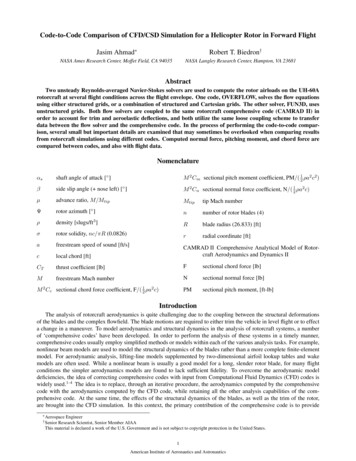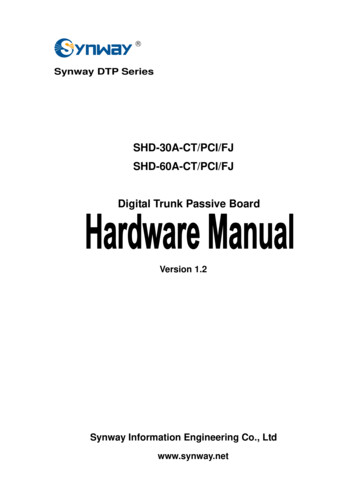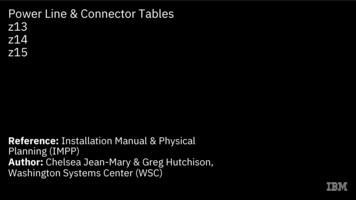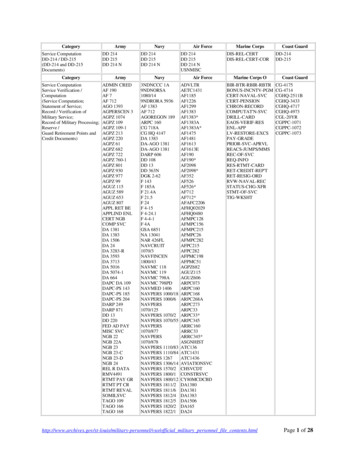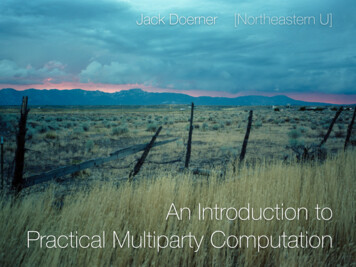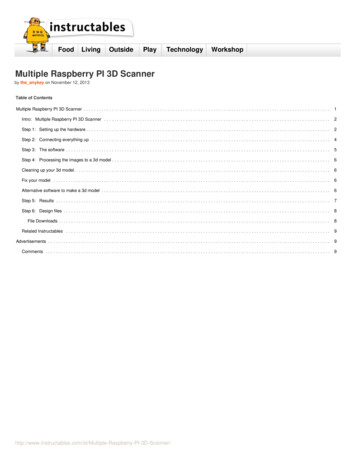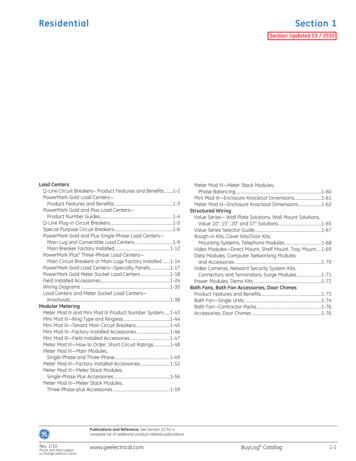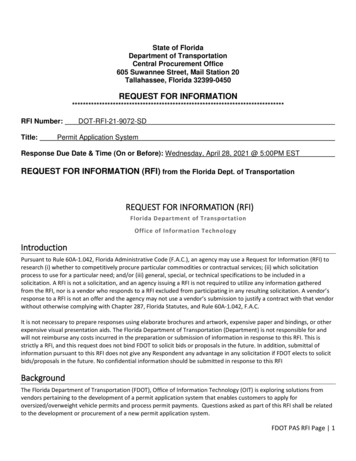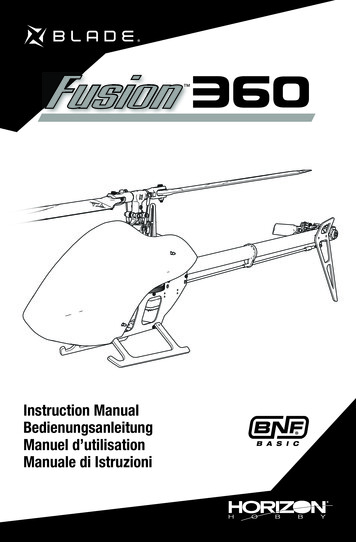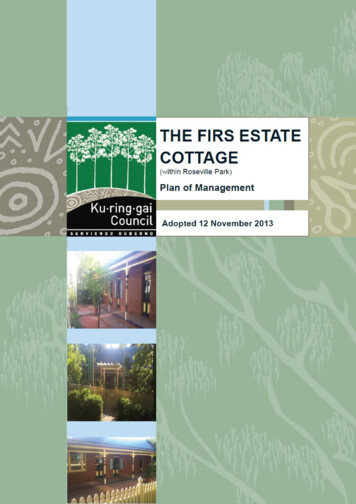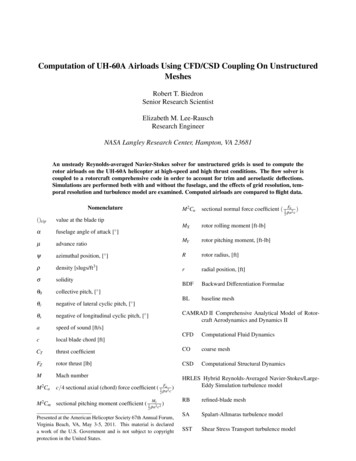
Transcription
Computation of UH-60A Airloads Using CFD/CSD Coupling On UnstructuredMeshesRobert T. BiedronSenior Research ScientistElizabeth M. Lee-RauschResearch EngineerNASA Langley Research Center, Hampton, VA 23681An unsteady Reynolds-averaged Navier-Stokes solver for unstructured grids is used to compute therotor airloads on the UH-60A helicopter at high-speed and high thrust conditions. The flow solver iscoupled to a rotorcraft comprehensive code in order to account for trim and aeroelastic deflections.Simulations are performed both with and without the fuselage, and the effects of grid resolution, temporal resolution and turbulence model are examined. Computed airloads are compared to flight data.NomenclatureM 2Cnsectional normal force coefficient ( 1 Fn 2 )MXrotor rolling moment [ft-lb]MYrotor pitching moment, [ft-lb]2 ρa()tipvalue at the blade tipαfuselage angle of attack [ ]µadvance ratioψazimuthal position, [ ]Rrotor radius, [ft]ρdensity [slugs/ft3 ]rradial position, [ft]σsolidityBDFBackward Differentiation FormulaeBLbaseline mesh[ ]θ0collective pitch,θcnegative of lateral cyclic pitch, [ ]θsnegative of longitudinal cyclic pitch, [ ]aspeed of sound [ft/s]clocal blade chord [ft]CTCAMRAD II Comprehensive Analytical Model of Rotorcraft Aerodynamics and Dynamics IICFDComputational Fluid Dynamicsthrust coefficientCOcoarse meshFZrotor thrust [lb]CSDComputational Structural DynamicsMMach numberM 2Cacc/4 sectional axial (chord) force coefficient (Fa1 ρa2 c )2My2 22 ρa cM 2Cm sectional pitching moment coefficient ( 1)Presented at the American Helicopter Society 67th Annual Forum,Virginia Beach, VA, May 3-5, 2011. This material is declareda work of the U.S. Government and is not subject to copyrightprotection in the United States.HRLES Hybrid Reynolds-Averaged Navier-Stokes/LargeEddy Simulation turbulence modelRBrefined-blade meshSASpalart-Allmaras turbulence modelSSTShear Stress Transport turbulence model
IntroductionThe prediction of rotorcraft airloads presents a significantchallenge for Computational Fluid Dynamics (CFD). Thecombination of complex flow physics, nonlinear structuraldynamics, and the geometrical complexity of rotorcraft allmust be accounted for. Significant progress has been madein the last decade toward meeting this challenge. Potsdam etal. (Ref. 1) combined the structured-grid CFD code OVERFLOW (Ref. 2) with the rotorcraft Computational StructuralDynamics (CSD) code CAMRAD II (Ref. 3) in a looselycoupled fashion and applied the coupled system to the UH60A Blackhawk helicopter. A code such as CAMRAD II isalso referred to as a ‘comprehensive’ code, because in addition to structural dynamics models, aerodynamic, propulsion, and trim models are provided. In a coupled CFD/CSDsystem, the CFD solver replaces the aerodynamic analysisof the comprehensive code, while the CSD code continuesto provide the structural dynamics and trim. The generallygood comparison with flight-test data obtained in Ref. 1renewed interest in the loose-coupling approach originallyproposed by Tung et. al (Ref. 4). Indeed, the loose-couplingmethod has now been applied by many other researchers,not only to the UH-60A, but to other configurations as well.Most of the CFD/CSD work to date has been performedusing structured-grid CFD solvers. Structured-grid solversare generally very efficient in terms of computational resources, but for complex geometries, the human effort required to generate the requisite grid systems can be significant. Unstructured-grid CFD solvers require greater computational resources, but the human effort to generate gridsabout complex geometries is typically far less. As a result,the total time to solution can be less for unstructured-gridsolvers. In Reference 5, the unstructured-grid CFD solverFUN3D (Ref. 6) was loosely coupled to the CAMRAD IIcode and applied to the HART-II configuration for threetest conditions. Abras (Ref. 7) coupled the FUN3D solverto the DYMORE CSD code and applied the resulting system to UH-60A high-speed and low-speed flight conditions.Sankaran et al. (Ref. 8) used a novel unstructured/cartesianhybrid solver coupled with the RCAS comprehensive codeto compute rotor airloads for several UH-60A flight conditions.In this paper, we apply the FUN3D/CAMRAD II analysis system to the UH-60A for two flight conditions,one high-speed and the other high-thrust. The UH-60Adatabase (Refs. 9, 10) has an extensive range of aerodynamic and structural-loads data at numerous flight conditions across the flight envelope and thus provides a veryuseful data set for validation of computational results. Thefocus here is on the validation of computed rotor airloads,and the assessment of the sensitivity of the airloads to several CFD-related inputs: grid size, turbulence model, andtime step. The sensitivities of the off-body aerodynamics(e.g. vortex propagation) to these variations is not considered. Although the emphasis is on aerodynamics, becausethe aerodynamics and structures do interact with one another some comparisons of structural loads from flight andcomputation are also presented. However, no attempt ismade to assess the sensitivity of the results to any structuralmodeling input.CFD/CSD MethodologyThe unstructured-grid flow solver used for this study isFUN3D. The code solves the Navier-Stokes equations, including the full viscous terms (i.e. the thin-layer assumption is not made), with several turbulence modeling options.FUN3D is a node-centered code, so that the number of unknowns is directly related to the number of nodes in thegrid. The code supports ‘mixed-element’ meshes in whichthe nodes may be connected into prismatic, hexahedral, orpyramidal elements instead of, or in addition to, tetrahedra.The solver has a variety of mesh-motion options, includingrigid, deforming, and overset meshes, and a robust implicittime-advancement scheme (Ref. 11). For overset meshes,the DiRTlib (Ref. 12) and SUGGAR (Ref. 13) codes areused to facilitate communication between disparate zonesin the mesh. These features make the solver attractive forrotorcraft applications, where the flow is fundamentally unsteady and the flexible rotor blades undergo large motionsrelative to the fuselage. O’Brien (Ref. 14) first applied theFUN3D solver to rotorcraft simulations, with the restrictionof rigid blades with prescribed motion. Subsequent modifications resulted in a more general rotorcraft capability, withthe ability to account for aeroelastic effects and trim viacoupling with the CAMRAD II rotorcraft comprehensivecode (Ref. 5). The coupling is implemented via the loosecoupling strategy outlined in Ref. 1, and thus is appropriateto steady, level flight.The rotorcraft CSD code used for this study is CAMRAD II. The aerodynamics modules within CAMRAD IIare based on lifting-line models utilizing airfoil tables, coupled with wake models. Although such aerodynamic models can provide reasonable results for many flight conditions, in some cases the predictions of the airloads can beinaccurate because of limitations of the relatively low-orderaerodynamic modeling. The goal of the loose coupling approach is to replace the low-order lifting-line aerodynamics of the CSD code with the higher-fidelity Navier-Stokesaerodynamics of the CFD code. Within CAMRAD II, eachblade is modeled as a set of nonlinear beam elements. Inaddition to the structural dynamics modeling, CAMRAD IIoffers a sophisticated trim capability. For the UH-60A simulations in this paper, a three-degree-of-freedom trim is utilized, with the (solidity-weighted) thrust coefficient, pitching moment and rolling moment specified as trim targetswithin CAMRAD II.In the loose coupling approach, airloads data from theCFD solver and blade motion data from the CSD solver areexchanged at relatively infrequent periodic intervals, for ex-
ample once per revolution or more generally once per integer multiple of the blade passage. In a typical coupled simulation, the initial execution of FUN3D is carried out for twocomplete rotor revolutions, using blade deformations froma trimmed CAMRAD II solution with unmodified liftingline aerodynamics. In subsequent coupling cycles, FUN3Dis run for two blade passages between coupling cycles (i.e.one-half revolution for a four-bladed rotor such as the UH60A). Although coupling could be performed as frequentlyas each blade passage, running the solver for the extra bladepassage helps damp out transients between coupling cycles.This coupling strategy has not been examined for optimality; however, it has proven to be a robust strategy (stableand convergent). The coupled system is tied together byseparate interface codes that perform data translation between FUN3D and CAMRAD II. A shell script is used toorchestrate the execution of the various codes, and to provide restart, post-processing, and archiving functions.CFD GridsThe baseline composite-grid systems for the isolated UH60 rotor were developed by over-setting component gridsfor each individual blade with an empty (background)square domain. The component unstructured grids forthe overset computations were generated with the VGRIDv4.0 advancing-layer and advancing-front grid generationsoftware package (Ref. 15). The grids generated withVGRID were fully tetrahedral. However, VGRID uses anadvancing-layer technique to generate the boundary-layerportion of the grid so that prisms can be reconstructed in theboundary layer for use with a mixed-element discretization.In the boundary layer, three tetrahedral cells are combinedinto one prism. The mixed-element grids have essentiallythe same number of nodes and nodal spacing as the fullytetrahedral grids although the number of cells and the shapeof the control volumes differ in the boundary layers.The blade surface geometry used for grid generation isbased on an updated definition provided by the SikorskyAircraft Corporation via the UH-60 Airloads Workshop inMay 2009. The updated geometry includes more spanwiseresolution at the tip cap and a correction to the spanwiselocation of the trim tab. The near-body blade grid extendsaway from the blade to a cylindrical outer boundary of radius 1.5ctip . In the wall normal direction, the grid spacing is set such that an average normalized coordinate y isless than one for the first grid cell at the wall for the majority of the blade. The maximum spacing at the blade gridouter boundary is approximately 0.10ctip . The characteristic spacings of the baseline rotor grid are summarized in Table 1. Note that these are the spacing values associated withthe VGrid “sources” which are used to control the unstructured grid spacing field, rather than the actual spacings between node points, though they are loosely correlated. Themaximum spanwise stretching is 30:1 near both the bladeleading edge (LE) and trailing edge (TE). The surface gridhas approximately 5 points across the blunt trailing edge.Each component blade grid has approximately 2.65 millionnodes. Figures 1(a)–(c) show a comparison of the surfacemesh near the tip of the rotor blade for the coarse, baselineand refined blade grids. Figures 1(d)–(f) show the corresponding slices taken through the blade volume grids at ther/R 0.865 radial station which is at the outboard edge ofthe trim tab.BladeSurfaceDirectionchordwisespanwiseat ristic Spacing0.0029c LE0.0014c TE0.0009R Root0.0056R Mid-Span0.0009R Tip2.62 10 6 ctip(geometric stretching 1.20)0.10ctipTable 1. Characteristic spacings of baseline blade grid.The off-body grid (background grid) for the isolated rotor is defined in a square box whose sides extend 5R outfrom the rotor hub. The finest spacing in the off-bodygrid is approximately 0.10ctip . This minimum spacing ismaintained, within the constraints of the unstructured meshing software, in a cylindrical volume which extends 1.1Rin the blade plane and 0.20R above and 0.20R below theblade plane. This cylindrical volume of refinement wasachieved by utilizing VGrid volume sources (Ref. 16). Thebackground component grid has approximately 7.0 millionnodes. The baseline composite grid has a total of approximately 17.6 million nodes. A slice through the baselineisolated UH-60 composite grid in Fig. 3 shows the spacingcharacteristics of the blade and off-body grids through thecomputational domain. The grids are shown in a verticalplane passing through the rotor hub location. Note that thefringe and hole points are not plotted.Although a mathematically consistent grid refinementstudy in the sense of Ref. 17 was not performed, alternative composite-grid systems were developed to look at theeffects of grid refinement: a globally coarsened grid and arefined blade grid. A comparison of global characteristicsfor these composite grids is provided in Table 2. The coarsecomposite grid was developed from the baseline grid by increasing the minimum off-body mesh spacing to 0.20ctipand increasing the baseline grid surface spacings by a factor of 1.3. This coarse composite grid has approximately6.9 million nodes. A refined blade grid was developed byglobally refining the blade surface-grid spacings by a factor0.73. The maximum spacing at the blade grid outer boundary was set to 0.10ctip so that this grid could be overset withthe baseline off-body grid.
Blade GridBackground GridComposite GridNodes (millions)Viscous Surface Nodes (thousands)Surface Spacing FactorWall Normal Spacing FactorCharacteristic Outer Boundary SpacingNodes (millions)Finest SpacingOuter Boundary ExtentTotal Nodes ade7.61260.731.000.10ctip7.00.10ctip5R37.4Table 2. Comparison of composite grid systems.An off-body grid containing the UH-60 fuselage bodywas developed to study the influence of the body aerodynamics on the rotor airloads. The fuselage surface geometry was provided by Sikorsky Aircraft Corporation. Therotor hub, shaft, and blade linkages are not modeled, nor isthe tail rotor modeled. Figure 2 shows the surface mesh forthe fuselage and the baseline rotor grid. The surface meshfor the fuselage body has 59,000 nodes. In the wall normaldirection, the grid spacing (3.80 10 7 ctip ) is set such thatan average normalized coordinate y is less than one for thefirst grid cell at the wall for the majority of the body. Theouter boundary of the fuselage grid is a square box whosesides extend 5R out from the rotor hub. This grid also contains a cylindrical volume of refinement in the vicinity ofthe rotor plane of motion similar to the one defined for theisolated rotor. The maximum spacing within this cylinderis not allowed to exceed 0.10ctip . The fuselage componentgrid has approximately 8.4 million nodes. When the fuselage grid is combined with the baseline rotor blades, theresulting composite grid has a total of approximately 19.2million nodes. A slice through the baseline rotor/fuselagecomposite grid in Fig. 3 shows the spacing characteristicsof the blade and off-body grids through the computationaldomain. The grids are shown in a vertical plane passingthrough the fuselage centerline (the fringe and hole pointsare not plotted). Note that when the fuselage is included,the rotor is inclined at the shaft angle, while for the isolated rotor, the rotor is not inclined, and the shaft angle isaccounted for in the specified angle of attack.For all composite grid systems, SUGGAR is used ina pre-processing step to create the composite grid and thedomain connectivity file (DCI) for the nominal rotor position. For dynamic overset cases, the DCI file is createdat each time step (azimuthal location) by calling a set ofSUGGAR library routines directly from FUN3D. SUGGAR offers a selection of hole-cutting algorithms. Forthis work, the direct-cut method was used to define theblanked points in the composite grid, and an overlap minimization process was used to identify fringe points. Adonor quality value of 0.9 was specified, and no orphanswere generated in the overlap process for the baseline andrefined-blade grids. The overlap process for the coarse gridgenerated a small number of orphans (on the order of a fewdozen) during part of the rotor revolution.Computational ResultsMost results presented here are obtained using a standardset of input parameters for CFD modeling. This standard or “best practices” set has emerged over the course ofnumerous rotorcraft simulations using the FUN3D solver.The standard computation utilizes a mixed-element meshwith prisms in the boundary layers near solid surfaces, andtetrahedra elsewhere. Inviscid fluxes are evaluated with asecond-order (in space) implementation of Roe’s scheme(Ref. 18). The standard turbulence model is the SpalartAllmaras turbulence model (Ref. 19). The turbulence modelis applied to both the near-body and off-body regions. Forthe present results, no rotational corrections to the turbulence model are utilized. Time advancement is carried outwith a modified second-order backward-difference dualtime scheme which results in reduced leading-order truncation error compared to the classical second-order backwarddifference scheme (Refs. 20, 21). The standard time stepcorresponds to a 1 change in blade azimuth per step. Timeadvancement is performed under the guidance of a ‘temporal error controller’ (Refs. 11, 20) in which dual-time subiterations are carried out within each time step until either theL2 norm of the nonlinear residual is reduced to a specifiedfraction of the estimated temporal error, or, a specified maximum number of subiterations have been performed. Forthe results presented here, the error fraction ranges from0.005 to 0.01, and the maximum number of subiterationsallowed ranges from 40 to 60.To assess the sensitivity of the computed results to several important CFD “parameters”, variations from the standard set described above are examined. The effect of celltopology is considered by using both tetrahedral and mixedelement grids. The effect of mesh refinement is consideredby performing isolated-rotor simulations using the coars-
ened, baseline, and refined-blade grids described above,with resolutions ranging from 6.9 to 37.4 million nodes.The influence of the fuselage on the rotor airloads is examined by replacing the empty-box background grid of thebaseline isolated-rotor mesh with one containing the fuselage, leaving the rotor grids unchanged. Sensitivity to timestep is examined using a step which corresponds to a 0.5 change in blade azimuth per step. Two additional turbulence models are considered: the Shear Stress Transport(SST) model of Menter (Ref. 22) and a hybrid model thatcombines the SST model near walls with a Large Eddy Simulation (LES) model of the subgrid-scale turbulent kineticenergy (Ref. 23).The two flight conditions considered in this paper are denoted as counters 8534 and 9020, and represent high-speedand high-thrust conditions, respectively. Table 3 summarizes the flight conditions and trim targets used for the simulations. Within CAMRAD II, the thrust target is specifiedvia the solidity-weighted thrust coefficient while the pitchand rolling moment targets are specified directly. The rotor is tilted relative to the fuselage by 3 (forward tilt, seeFig. 3). This tilt is accounted for in the angle of attack usedin the simulation when running isolated rotor analyses.Figure 4 illustrates the radial stations at which flighttest data were collected on one of the rotor blades. Here,airloads are presented at a subset of these measurementstations, with comparison of flight data and computed results for normal force, pitching moment, and chord forcevs. blade azimuth at selected stations. The zero position forblade azimuth is defined as that for which the blade is nominally aligned with the fuselage axis, pointing aft. Computational results for forces and moments include both pressureand skin-friction contributions, whereas flight data only include pressure contributions. The plots at each selected station are presented in a triptych format, which makes it easyto see the simultaneous effects of an ‘event’, such as dynamic stall, on all three quantities. Sectional airloads ateach radial station are presented in nondimensional form,with freestream speed of sound used as the reference velocity - e.g. M 2Cn . Note that means are removed from the sectional airloads plots. It is known that there are discrepanciesin some of the flight data due to faulty pressure taps. Plotting data with the means removed masks some of these discrepancies and facilitates assessment of the computationaltrends relative to flight. However, mean airloads (averagedaround the rotor disk) are also compared as a function ofradius in order to assess the agreement of the absolute levels. The sectional airloads plots are used to illustrate thesensitivity of the computed results to changes in CFD parameters. To keep the number of figures to a manageablelevel, most plots are structured to show the sensitivity ofthe airloads (means removed) to the particular parameterunder consideration at two of the nine radial stations, alongwith the sensitivity of the mean airloads as a function ofradius. The two stations chosen are either the two showingthe most sensitivity, or one showing the most sensitivity andone showing a typical level of sensitivity.Counter 8534: High-Speed ConditionFlight counter 8534 has become a canonical case forCFD/CSD validation, so that condition is considered first.This flight condition represents the highest level-flightspeed in the UH-60A Airloads Database, as well as theflight condition with the highest vibration levels. Thesalient features for this flight condition are given in Table3.To examine the effects of mesh size, computations onthree different mixed-element meshes, containing between6.9 million to 37.4 million nodes, are shown in Figure 5for an isolated rotor. The top section of Figure 5 showsthe variation of airloads with azimuth angle for stationr/R 0.965, while the mid section shows the variation atr/R 0.990 and the bottom section illustrates the mean (azimuthally averaged) variation with radius. The level of differences observed at station r/R 0.965 are typical of differences seen at other stations. By far the largest differencesare observed near the tip at r/R 0.99. Considering themean airloads (averaged around the rotor disk) as a function of radius, the normal force is reasonably well predicted,the pitching moment less so, and the chord force is poorlypredicted past r/R 0.40. The flight data for both pitching moment and chord force exhibit a significant amount ofvariation from station to station past r/R 0.40. The computational results exhibit much less station-to-station variation than the flight data, although the trends past r/R 0.80appear similar. Mesh refinement has virtually no effect onthe mean airloads. Similarly, time-step refinement, shownin Figure 6, shows no effect on the rotor airloads as the stepis reduced from the standard value of 1.0 to 0.5 . In a recent paper by Sitaraman et al. (Ref. 24), using feature-basedoff-body adaption, a similar lack of sensitivity of rotor airloads to mesh refinement was observed for the high-speed(C8534) flight condition.It should be noted that trim targets for rotor thrust andpitch/roll moments used in the CFD/CSD coupling processare indirectly generated from flight data using estimatesof the vehicle gross weight, tail plane loads, and fuselageloads. They are not obtained by integration of the measuredsectional loads. Thus differences in the mean sectional airloads and moments between computation and flight do notindicate that the specified trim targets are not met.Figure 7 shows the comparison of data and computedresults for an isolated rotor obtained using both a fullytetrahedral mesh and a mixed-element mesh. Both mesheshave identical point distributions, approximately 17.6 million nodes. With means removed, the variation of the computed airloads with blade azimuthal angle generally agreewell with the flight data. Other stations show similar levels of agreement between flight data and computation. Very
Counter85349020α(deg) 4.312.49µ0.3640.245Mtip0.6420.669CT /σ0.0810.118MY (ft-lb) 4169 2176MX (ft-lb) 6042 616Table 3. Flight conditions and trim targets; sign conventions: α nose up, MY nose up, MX right side down.little difference is observed in the computed results on thetwo meshes for this flight condition. The largest differencesare seen near the rotor tip, where the mixed-element meshresult matches the data slightly better than the tetrahedralmesh. In fact at r/R 0.990 the results on the 17.6 millionnode tetrahedral mesh are nearly identical to the results onthe coarsest mixed-element mesh shown in Figure 5. For allother stations not shown, the differences between the tetrahedral mesh results and the mixed-element mesh results arevery small indeed, comparable to the differences observedat r/R 0.865. The use of the mixed-element grid resultsin slightly better agreement in the mean chord force alongthe blade. The mean normal force and mean pitching moment are virtually indistinguishable between the two computations.The effect of the fuselage is shown in Figure 8 at the twoinnermost radial stations. Although not shown, the effect ofthe fuselage on the airloads for r/R 0.5 is much less significant than at stations inboard. For the innermost stations,inclusion of the fuselage results in a general improvementin the correlation between computation and flight data overthe forward part of the rotor disk, particularly for the chordforce and pitching moment. No substantial change in thecorrelation with flight data over the aft portion of the rotordisk is obtained by including the fuselage; this area maybe more strongly influenced by the hub (not included in thepresent computations). The mean airloads show virtually nosensitivity to the presence of the fuselage for the outboardsections of the blade, and only minimal differences for theinboard stations.Next, for an isolated rotor, using the baseline, mixedelement grid, variations of turbulence model (SA, SST andHRLES) are considered. Results are shown for stationsr/R 0.965 and r/R 0.99 in Figure 9. Most surprisingly,none of the turbulence models, for this flight condition, produced any noticeable change in the computed results. Although the mesh is fairly fine and relatively isotropic in theregion of the rotor disk, it is an open question whether thegrid is fine enough, and the time step small enough, to bestexploit the the HRLES model.Table 4 summarizes the sensitivity of the blade controlangles required for trim of the rotor to the various CFD parameters discussed above. As expected from the lack ofsensitivity of the airloads for this flight condition, the control angles show very little change with parameter variation,a few tenths of a degree at most. In addition, Table 4 summarizes the sensitivity of the computed thrust and torquecoefficients to CFD parameter variation. Taking the baseline, mixed-element mesh for the isolated rotor as the reference result, over the range of parameters considered, thrustvaries by no more than 0.3 percent, and torque varies by nomore than 3.5 percent.Next the structural loads computed within the coupledCFD/CSD process are compared with those obtained fromflight. The UH-60A database contains measured data fortorsional moments, normal (flap) moments, and edgewise(chordwise) moments at several stations not coincident withthe airloads stations. Figure 10 shows the comparison ofcomputed and measured torsion moment at four radial stations, while Figures 11 and 12 show normal and edgewise bending moments, respectively. The results are shownfor the baseline, mixed-element mesh for an isolated rotor,the corresponding tetrahedral mesh, and the mixed-elementmesh with the fuselage, all with 1 time step and the SAturbulence model. Of the CFD parameter variations considered, these three cases span the range of variation in thestructural loads. As with the airloads, means have been removed. In Figure 10, the torsional moment at r/R 0.0466has been obtained indirectly from the pitch-link load and thepitch-link load offset of 0.0224R; the same procedure wasdone for both flight and computation. In general, the 1/revvariation of torsional and normal-bending moments are reasonably well predicted by the computation. Higher harmonics are not well captured, especially for the flap-bendingmoment at r/R 0.113. Overall the edgewise bending moments are rather poorly predicted, even for the lowest harmonic. As suggested by the airloads predictions, the structural loads show the most sensitivity to the inclusion of thefuselage, although the influence of the fuselage on the results is small.Counter 9020: High-Thrust ConditionFlight counter 9020 represents a high-thrust condition at amoderate advance ratio; the conditions for this counter aresummarized in Table 3. The high-thrust level leads to dynamic stall for several radial stations on the retreating side.Mesh refinement was also carried out for counter 9020.For this counter, unlike counter 8534, acceptable iterativeconvergence during each time step was typically not obtained using a step of 1 on the refined blade grid. Forthat mesh, with a step of 1 , convergence at nearly all timesteps would “hang”, and fail to reach the specified temporal error tolerance (0.01 times the residual norm); because
-isoBL-mix-isoBL-mix-isoBL-mix-fuseTime Step1.0 1.0 1.0 1.0 0.5 1.0 1.0 1.0 Turb. 2.71θ1s 8.99 8.94 8.95 8.97 8.97 8.95 8.96 06830.0006810.0006850.000673Table 4. Sensitivity of control settings (measured at pitch hinge), thrust, and torque with respect to CFD parameterv
An unsteady Reynolds-averaged Navier-Stokes solver for unstructured grids is used to compute the rotor airloads on the UH-60A helicopter at high-speed and high thrust conditions. The flow solver is coupled to a rotorcraft comprehensive code in order to account for trim and aeroelastic deflections.
